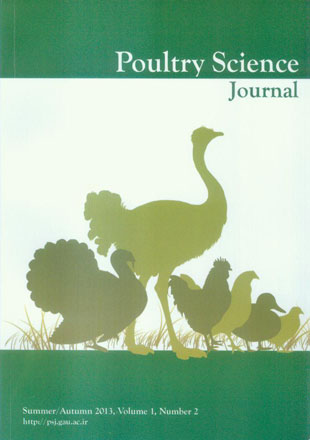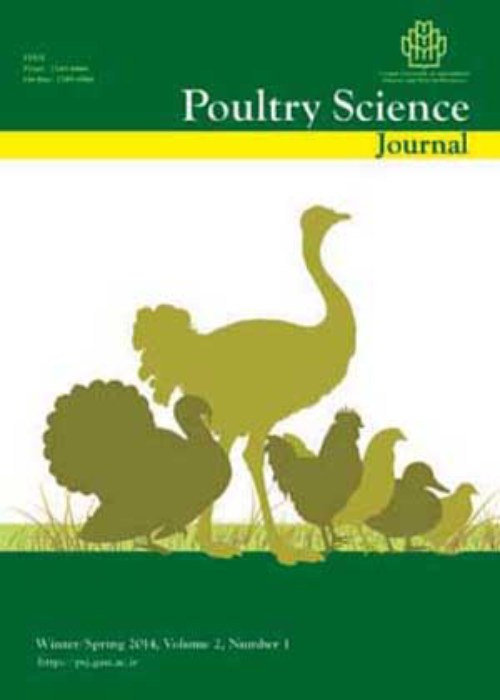فهرست مطالب

Poultry Science Journal
Volume:1 Issue: 2, Summer-Autumn 2013
- تاریخ انتشار: 1392/08/17
- تعداد عناوین: 6
-
-
Pages 63-77The objective of this study was to evaluate the efficiency of water pressure and concentration of dichloromethane after the evisceration system under the fecal decontamination of chicken carcasse surfaces with and without apparent contamination. From a total of 322 carcasses, 50% were intentionally added chicken droppings in an area of more than 2 cm2 and the rest of carcasses were kept without fecal inoculation. Escherichia coli and Enterobacteriaceae counting was carried out in samples immediately after the inoculation (initial counting) and after different treatments. Treatments consisted of water with different pressures (1.5, 3.5 and 5.5 Kgf/cm2), and the addition of a echnological adjuvant (dichloride) at the concentrations of 0, 5 and 10 ppm. The results were validated using 40 chicken carcasses for each treatment by means of a 22 factorial statistical design. The results showed no significant differences (P<0.05) between the carcasses with and without initial apparent fecal contamination after passing through the washing nozzles, related to the E. coli and Enterobacteriaceae countings and the visual characteristics (32 judgers) of the products. The binomial pressure-adjuvant concentration influenced the result of microbiological analyses of chicken carcasses; the water pressure demonstrated higher influence compared to the adjuvant concentration. Most of the treatments showed satisfactory results on the fecal decontamination.Keywords: Washing, Broiler carcass, Quality control, Decontamination
-
Pages 79-85The present study was carried out to investigate the polymorphism of intron 3 to exon 3 of prolactin gene containing 24 bpindel at nucleotide position (np) 358 and its association with some reproductive traits in Japanese quail. These traits consisted of weight (WSM) and age at sexual maturity (ASM), mean egg weight at 2nd, 4th, 6th, and 2-6th weeks (MEW), and the number of eggs during the 2nd, 4th, 6th, and 2-6th weeks of laying period (EN). Blood samples of 194 Japanese quail at 13wk of age were collected randomly. DNA was extracted from blood samples and amplified. The association of prolactin genotypes with reproductive traits was analyzed using the general linear model procedure of SAS software. A 24-bp indel[insertion (I) or deletion (D)] at np358 was identified. Based on the results obtained, the frequency of I and D alleles were 0.52 and 0.48, respectively. Frequencies of II, ID and DD genotypes were 0.10, 0.85 and 0.05, respectively. Genotypes II and ID were significantly associated with increased EN (P0.05). The results showed that prolactin gene polymorphism could be used to improve egg production in Japanese quail through marker-assisted selection.Keywords: Prolactin gene, Polymorphism, Reproductive traits, Japanese quail
-
Pages 87-92Present investigation was carried out to identify DNA polymorphism of IL-2Rγ and ChB6 genes. Sixty five birds belonging to the indigenous chicken of Himachal Pradesh were utilized. Good quality DNA samples were subjected to PCR-RFLP analysis using chicken specific primers. Overnight restriction enzyme digestion was carried out at 37°C with IU Hph I and Pvu II for IL-2Rγ and ChB6 genes, respectively. Amplification of IL-2Rγ gene resolved a 600 bp amplicon in all samples, which upon digestion with Hph I RE yielded three patterns i.e. Hph I aa, Hph I a/b and Hph I bb. Hph I aa genotype revealed 465 and 42 bp fragments while Hph I bb genotypes revealed 454, 134, 104 and 42 bp fragments. Hph I a/b genotype resolved 465, 454, 134, 104 and 42 bp fragments. The frequencies of these patterns were 0.47, 0.23 and 0.30 for Hph I aa, Hph I a/b and Hph I bb, respectively. The amplification of Chicken B cell marker (ChB6) generated 215 bp amplicon in all the samples, which upon digestion with Pvu II generated two pattern i.e. Pvu II aa and Pvu II bb respectively. Pvu II aa generated 215 bp fragments while Pvu II bb generated 215, 147 and 68 bp, respectively. The frequencies of the PCR-RFLP pattern of ChB6 gene were 0.57 and 0.43, respectively.
-
Pages 93-104A total of 448 Ross 308 male broiler chickens were assigned to seven treatments with four replicates, each containing 16 chicks. The birds were reared from d 21 to 42 and effects of physical sizes (<0.25 mm, 0.4- 0.8 mm and 1- 2 mm) and levels of clinoptilolite (1.5 and 3%) were examined. They were fed ad libitum by a basal commercial broiler diet with 3050 Kcal/Kg ME and 19.06% CP/Kg from 21 to 42 d. The chickens which received clinoptilolite (1.5% with particle size of 0.4-0.8 mm) showed a significant increase in body weight gain compared to the control group birds receiving no clinoptilolite (P<0.05). Adding clinoptilolite to the diet caused a significant improvement in feed conversion ratio in days 21-28, 28-35, 35-42 and 21-42 (P<0.05). Broilers fed 1.5% clinoptilolite with particle size of 0.4- 0.8 mm had lower feed conversion ratio compared to the other groups. The highest level of blood glucose, total protein and albumin were found in birds receiving 1.5% clinoptilolite with the particle size of 0.4- 0.8 mm, while the lowest level of blood glucose, total protein and albumin were obtained in the control groups (P<0.05). The lowest litter moisture was observed in the groups fed with 3% clinoptilolite with a particle size of 1-2 mm. Therefore, it can be concluded that supplementation of the diet with clinoptilolite has positive effects on performance and litter moisture in broilers.Keywords: Broiler, Clinoptilolite, Litter quality, Physical size
-
Pages 105-116This experiment was conducted to evaluate the ability of Silybum marianum seeds (SMS) on performance, carcass variables, and liver morphology of the broiler chickens contaminated with aflatoxin B1 (AFB1). A total of 216 broiler chicks (Ross 308) were used. Birds were randomly assigned to nine treatment groups, with four replicates and six birds in each replicate. Chickens were reared on litter from 1 to 35 days of age. Treatments were (AFB1) in three levels (Zero, 250 and 500 ppb) and SMS in three levels (Zero, 0.5 and 1.0 percent) using factorial experiment based on completely randomized design. Feed intake at the end of the three weeks did not significantly change in comparison with the control group. With the increase in the level of (AFB1) in the diet, feed intake and body weight gain were decreased compared with the control group in week 4. Feed conversion ratio was not influenced by the treatments. In diets containing AFB1, breast muscle, carcass ratio, abdominal fat and bursal gland weight were significantly decreased (P1 alone did not affect thigh, back, neck, wings, heart, legs and spleen weights. Increasing the level of SMS in the diet alone or in combination with AFB1 resulted in significant changes in the weights of carcass and internal organs. Liver of birds fed diets containing AFB1 showed abnormal signs including enlargement, yellowish, friable and rounded shape. Liver of other treatments did not show any abnormal signs. In conclusion, these findings suggest that silymarin might be used in chickens to prevent the effects of AFB1 in contaminated feed.Keywords: Broilers, Aflatoxin B1, Morphology, Performance, Silybum marianum seed
-
Pages 117-125From the last few years, the inclusion of microbial phytase in poultry diets has increased significantly, mainly in response to heightened concerns over phosphorus pollution of the environment and as cheaper means to make phosphorus available to birds from phytate. Phytate is the major form of phosphorus, abundantly found in cereal grains, beans and oilseed meals used in poultry diet but the monogastric animals like poultry birds are unable to utilize this source of phosphorus due to lack of endogenous phytase enzyme. To meet the phosphorus requirements of poultry birds, inorganic phosphates are added to the poultry rations, which lead to the problem of environmental pollution as a large amount of phosphorus is excreted in the manure. Microbial phytase is used as an alternative of this, which has beneficial effects on the growth performance, feed efficiency, protein/amino acid digestibility, energy utilization, mineral retention, and bone growth of broilers due to the direct hydrolytic effects on phytate.Keywords: Phytase, Microbial phytase, Energy, Broiler


